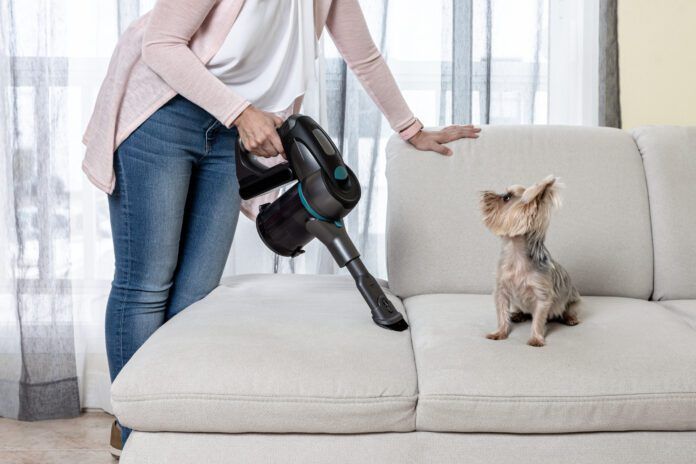If you want to break the flea lifecycle, it’s all-hands-on-deck. These tiny jumping parasites can quickly infest your home and wreak havoc on your dog. The faster you gain control over an infestation, the better. To get this done, we looked at the methods that are most effective, both natural and chemical.
Right off the bat, we’re going to tell you that we like natural flea killers for use in the house, when appropriate. We find Fleabusters RX for Fleas Plus Powder a top choice. But, for heavy-duty ammunition, we go to commercial methods, reaching for Knockout spray by Virbac to fully combat these unwanted guests in your house.
Remember, though, you still need to rid your dog of fleas to break the lifecycle (more on that below). While experts estimate that 95% of the flea problem is in the house with only 5% blamed on the dog, the fleas are still mainly coming in on the dog.
How to Get Rid of Fleas in the House
While each adult flea only lives a few weeks, the females stay very busy, laying approximately 50 eggs a day or about 1,000 eggs over her lifetime. Then, it takes at least three weeks for each of those 1,000 eggs to become an adult. So, let’s say half the eggs are female. So now we have 500 fleas, laying 50 eggs a day, for 20 days, which equals 500,000 flea eggs laid in your home within six weeks of that one flea entering the premises. As we said, you need to get on top of the situation immediately.
Basic steps to get rid of fleas in the house include using an integrated flea-control program that includes killing adult fleas and larvae. Start with:
- Heavy daily vacuuming, including heavy pet traffic areas and underneath furniture and beds (flea larvae migrate to dark areas). Empty the vacuum bag or canister every time you vacuum.
- Keep your car vacuumed if you transport your pets.
- Regularly wash bedding in hot water.
- Consider using an insecticide (spray or fogger, but sprays are easier to control) on your carpets and upholstered furniture; choose a spray that kills both adult fleas and pre-adult fleas and larvae. Foggers release insecticide into the air to eliminate fleas throughout your home. They are fast-acting and effective for large areas but can be toxic to humans and pets, requiring you to temporarily evacuate your home and be sure it can’t get to any food. Check the EPA website, which offers precautions.
- Don’t forget your yard. A yard that is sunny, dry, and cut short is less attractive to fleas than a yard that is heavily shaded and moist. If you have a shady, damp yard, use an outside area treatment to knock down the fleas.
Note: For severe or persistent infestations, consider contacting a professional pest control service. They have the expertise and specialized equipment to effectively eliminate fleas from your home.
Does Diatomaceous Earth Kill Fleas?
You don’t have to rely on chemicals to kills fleas. Diatomaceous earth, a naturally occurring substance derived from the fossilized remains of diatoms (microscopic, single-celled algae), is one option. Diatoms have hard, silica-based cell walls that, when fossilized, form a fine powder with sharp, microscopic edges. When applied to areas where fleas are present, these sharp edges can puncture the fleas’ exoskeletons, leading to dehydration and death.
Typical questions about using diatomaceous earth are usually:
- Is diatomaceous earth safe for dogs? Food-grade diatomaceous earth is generally considered safe for dogs. However, it can irritate their eyes, nose, and mouth, so don’t let your dog inhale or ingest it. You can purchase food-grade diatomaceous earth at online retailers like Amazon and Chewy, as well as home improvement, feed, and garden stores. Avoid pool-grade diatomaceous earth, as it may contain impurities harmful to dogs and other animals.
- How long should you leave it on the carpet? Diatomaceous earth works best when left undisturbed for at least a week, allowing fleas time to encounter it. Vacuum regularly to remove dead fleas and debris.
- How do you spread it? Sprinkle diatomaceous earth liberally on carpets, rugs, furniture, and other areas where fleas may hide, paying special attention to cracks and crevices.
- Can diatomaceous earth kill fleas in the yard? Yes, diatomaceous earth can be used in yards. Focus especially on cool, shady areas. Remember fleas love humidity and hate direct sunlight.
Does Baking Soda Kill Fleas?
Baking soda is another purported home remedy for fleas. While it may dehydrate fleas to some extent, it’s not as effective as diatomaceous earth or chemical methods and may take days or even weeks to work. Similarly, salt water might drown some fleas, and dry salt may dehydrate them, but neither are practical or effective methods for treating infestations.
Other myths according to Holistic Vet Blend include using garlic and Brewer’s yeast as a flea repellent. No scientific evidence supports its effectiveness, according to the site’s founder, Dody Tyneway Robi, DVM
Flea Prevention Is Key
Once you’ve eliminated the infestation, you need to be diligent about preventing them from returning, says the CDC:
- Regularly vacuum and clean pet bedding. Fleas thrive in warm, humid environments, finding refuge in carpets, bedding, and pet areas.
- Mow your yard frequently, avoid overwatering, and remove debris that provides shade and moisture. Fleas cannot tolerate direct sunlight.
- Discourage stray animals from hanging out in your yard.
- Prevent your dog from contacting wild animals.
- Apply appropriate flea preventatives to your pets.
Your Flea Options for Dogs
Applying a flea product to your dog is much simpler than getting fleas out of your house. If you prefer the simplicity of commercial products, consider these flea-prevention options:
Topical Treatments: Applied directly to the skin at the back of the neck, these spot-on treatments contain insecticides that kill adult fleas.
Pros: Easy to apply and effective against adult fleas.
Cons: May not eliminate eggs or larvae, and some pets may experience adverse reactions.
Flea Collars: These collars release insecticides gradually to repel and kill fleas.
Pros: Provide long-lasting protection and are convenient.
Cons: May be less effective than topical treatments, and some pets may develop allergies.
Oral Medications: These usually once-a-month medications kill fleas within your pet’s digestive system.
Pros: Effective against all flea life stages.
Cons: Can be more expensive and may have side effects.
The American Veterinary Medical Association (AVMA) emphasizes that flea protection is not one-size-fits-all prospect. Factors like your dog’s age, species, breed, lifestyle, health status, and current medications affect the type and dose of product you choose.
The AVMA recommends working with your veterinarian to choose the best option and suggests asking them these questions:
- What parasites does this product protect against?
- How often should I use/apply the product?
- How long will it take for the product to work?
- If I see a flea on my dog, does that mean it’s not working?
- What should I do if my dog reacts to the product?
- Is there a need for more than one product?
- How should I apply multiple products on my dog?
The AVMA advises caution when considering flea/tick treatment for very young and very old dogs. Use a flea comb on puppies too young for flea/tick products. Some products are unsuitable for very old pets, and certain breeds are sensitive to ingredients that can make them extremely ill.
Flea preventives and some medications can interact, causing unwanted side effects, toxicities, or ineffective doses. Inform your veterinarian of all your pet’s medications when discussing flea prevention options.





